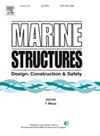CFRP-patch sizing for strengthening perforated steel tubular structures
IF 5.1
2区 工程技术
Q1 ENGINEERING, CIVIL
引用次数: 0
Abstract
The use of statistical and non-parameter-based modeling approaches to size a CFRP-patch thickness to restore the intact compressive capacity of perforated steel tubular structures is examined in this paper. Firstly, the effect of the perforation is assessed using non-linear FEM simulations of full-scale tubular structures with multiple levels of slenderness and cutout sizes. Secondly, the contribution of the CFRP-patch to the strengthening of damaged structures is evaluated using a full-factorial design-of-experiment of FEM-models that vary both the ultimate compressive strength and the elastic modulus of the CFRP properties in the longitudinal direction to properly populate a database with the models’ responses. Thirdly, a dataset with thicknesses that restore each damage case's observations to their intact capacity is created. This was accomplished using an ensemble learning method applied to the responses database to estimate the proper CFRP-patch thickness while considering a Hashin's damage criterion level. Finally, a multilinear regression methodology is adopted to describe the dataset, based on the sample and CFRP-patch explanatory variables as well as the Akaike information criterion to fit a model of response surface for the suggested thicknesses. The response predictions from simulated samples with suggested thicknesses are then compared with the ones retrieved from their respective intact models to assess the fitted model's level of effectiveness. Responses from strengthened samples are comparable to those obtained from intact samples, indicating that the fitted model for inferring the CFRP-patch thickness can suggest suitable values of thickness to recover the intact capacity of the samples with ±3 % deviation range.
穿孔钢管结构加固用cfrp补片施胶
本文研究了使用统计和非参数建模方法来确定 CFRP 补丁厚度的大小,以恢复穿孔钢管结构的完整抗压能力。首先,使用非线性有限元模拟对具有多级细长度和开孔尺寸的全尺寸管状结构进行评估。其次,通过改变 CFRP 特性在纵向的极限抗压强度和弹性模量的有限元模型的全因素试验设计,评估了 CFRP 补丁对加固受损结构的贡献,以便将模型的响应适当填充到数据库中。第三,创建一个数据集,其厚度可将每个损坏案例的观测值恢复到其完好的承载能力。为此,对响应数据库采用了集合学习方法,以估计适当的 CFRP 补丁厚度,同时考虑 Hashin 损伤标准水平。最后,根据样本和 CFRP 补丁解释变量以及 Akaike 信息准则,采用多线性回归方法来描述数据集,以拟合建议厚度的响应面模型。然后,将建议厚度的模拟样本的响应预测值与各自完整模型的预测值进行比较,以评估拟合模型的有效性。加固样品的响应与完整样品的响应相当,这表明用于推断 CFRP 补丁厚度的拟合模型可以建议合适的厚度值,以恢复样品的完整承载能力,偏差范围为 ±3 %。
本文章由计算机程序翻译,如有差异,请以英文原文为准。
求助全文
约1分钟内获得全文
求助全文
来源期刊

Marine Structures
工程技术-工程:海洋
CiteScore
8.70
自引率
7.70%
发文量
157
审稿时长
6.4 months
期刊介绍:
This journal aims to provide a medium for presentation and discussion of the latest developments in research, design, fabrication and in-service experience relating to marine structures, i.e., all structures of steel, concrete, light alloy or composite construction having an interface with the sea, including ships, fixed and mobile offshore platforms, submarine and submersibles, pipelines, subsea systems for shallow and deep ocean operations and coastal structures such as piers.
 求助内容:
求助内容: 应助结果提醒方式:
应助结果提醒方式:


